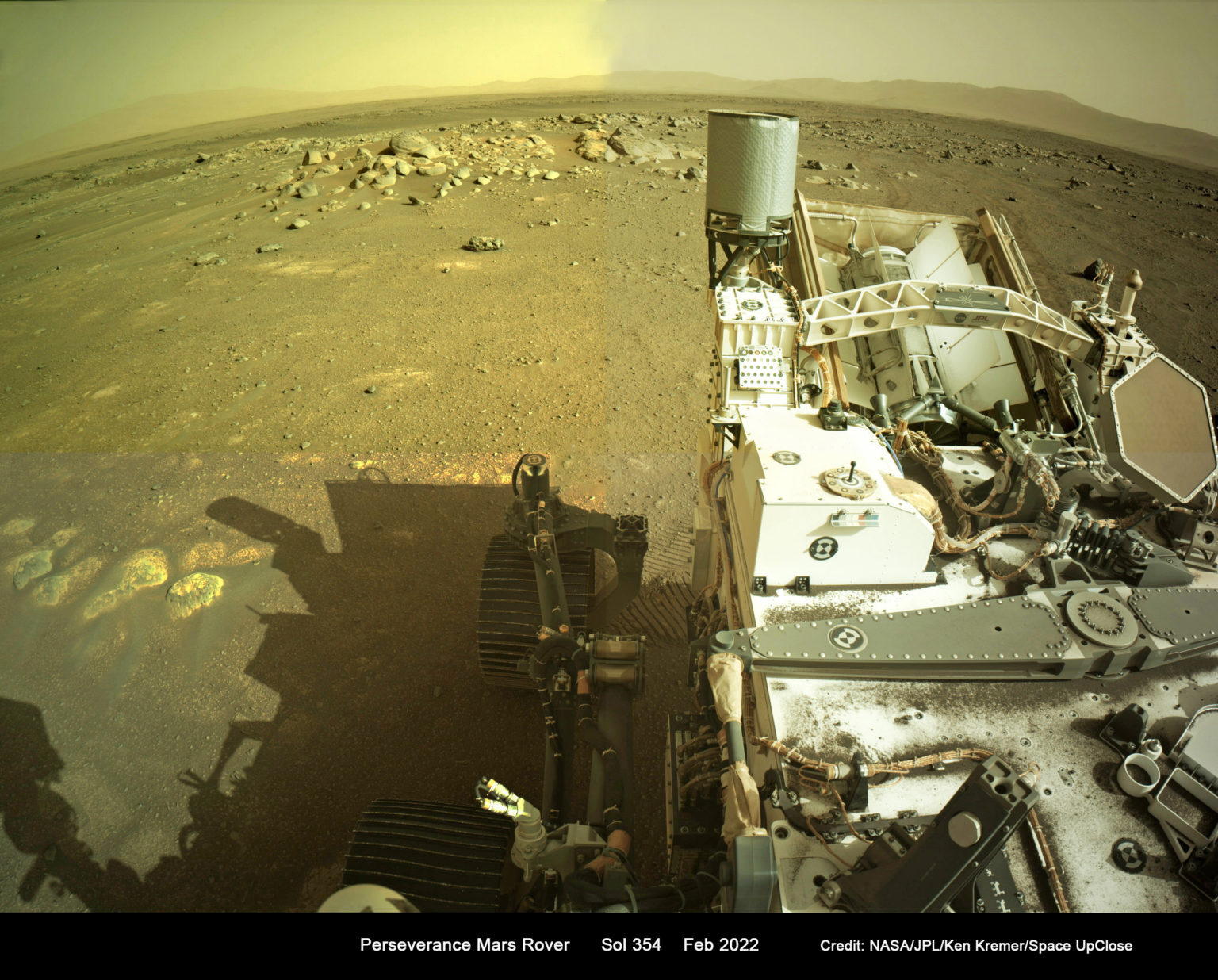


The Mastcam-Z camera onboard NASA's Perseverance rover captured a spectacular view of Phobos, one of Mars's moons, passing in front of the Sun during a partial eclipse on September 30, 2024. This rare event showcased the unique, irregular shape of Phobos, leading scientists to question its origin and potential relationship with Mars. While this is not the rover's first observation of a Phobos transit, it continues to provide valuable insights and images with its advanced technology. Don't miss out on all the latest tech news and updates by following Gadgets 360 on multiple platforms.
NASA's Perseverance Rover Captures Spectacular Eclipse of Mars' Moon Phobos
NASA's Perseverance rover has captured stunning images of a partial solar eclipse on Mars, showcasing the unique shape of Phobos, one of the planet's two moons. This rare celestial event occurred on September 30, 2024, and was captured by the rover's Mastcam-Z camera.
Background on Phobos and Solar Eclipses on Mars
Phobos is the larger of Mars' two moons, with an irregular potato-like shape and a diameter of approximately 22.2 kilometers (13.8 miles). It orbits Mars at a distance of about 6,000 kilometers (3,700 miles), completing one orbit every 7 hours and 39 minutes.
Solar eclipses occur on Mars when Phobos or the smaller moon, Deimos, passes between the Sun and Mars. However, due to their small sizes, these eclipses are not total eclipses but rather partial or annular eclipses.
Perseverance's Observation of the Phobos Transit
The Mastcam-Z camera on Perseverance captured a series of images of the Phobos transit on September 30, 2024. The images reveal the moon's distinctive shape and show it moving across the Sun's disk. Scientists were particularly interested in observing the moon's irregular shape, which has led to speculation about its origin and potential relationship with Mars.
Scientific Significance of the Observation
The images captured by Perseverance provide valuable insights into Phobos' origin and evolution. By studying the moon's shape and composition, scientists can gain a better understanding of its formation and history. Additionally, the eclipse observations can help scientists better understand the dynamics of the Mars-Phobos system.
Top 5 FAQs Related to Phobos and Solar Eclipses on Mars
What is Phobos? Phobos is the larger of Mars' two moons, with an irregular potato-like shape.
How often do solar eclipses occur on Mars? Solar eclipses occur on Mars whenever Phobos or Deimos passes between the Sun and Mars. However, these eclipses are not total eclipses but rather partial or annular eclipses.
Why is Phobos' shape unique? Phobos has an irregular shape, unlike many other moons in our solar system. Scientists believe that this shape may be the result of a collision or other catastrophic event.
What is the significance of observing Phobos' transit? Observations of Phobos' transits can provide valuable insights into the moon's origin, composition, and relationship with Mars.
How does NASA observe Phobos and solar eclipses on Mars? NASA uses rovers and other spacecraft to observe Phobos and solar eclipses on Mars. The Mastcam-Z camera on Perseverance is a particularly powerful tool for capturing images of these events.

In a recent family vlog, Indian celebrity couple Shoaib Ibrahim and Dipika Kakar shared their "natural" hair care routine for their son, using a homemade mask made with rice flour, flax seeds, and coconut oil. However, experts warn that what works for adults may not be suitable for babies, whose sensitive skin and scalp could react to the ingredients. While the ingredients may improve hair texture, they do not necessarily promote hair growth. Instead, a healthy diet and good scalp care are more important in maintaining healthy hair.

A recent consumer study has found multiple brands of soft contact lenses in the U.S. to contain "forever chemicals" that can be harmful to both the body and the environment. The study, conducted by the nonprofit organization Environmental Health Sciences, tested 18 varieties of popular contact lenses and found all of them to contain markers for PFAS. Brands such as Acuvue, Alcon, and CooperVision were among the list of affected products. This news serves as a cautionary lesson on the potential risks of overusing contact lenses.

On the birth anniversary of Dr. APJ Abdul Kalam, the ‘Missile Man’ of India, tributes pour in on social media celebrating his life, vision and impact. A visionary scientist, inspiring leader and true patriot, Dr. Kalam's humility, compassion and constant interaction with students continue to inspire generations. His tireless efforts in defense, science and youth empowerment have strengthened India's path towards self-reliance and his legacy continues to motivate young minds to dream big and work hard for the nation.

Recent studies have found that extreme heat, particularly when combined with high humidity, can have a significant impact on mental health. A study in India showed that when wet bulb temperature exceeded 27°C, the probability of reporting severe depression increased by 0.5%, even when the temperature was slightly lower. This finding is consistent with global reviews that have linked high temperatures to mood disorders, increased hospital admissions for psychiatric conditions, and even elevated suicide risk. The Lancet has also published evidence that rising temperatures worldwide are a growing threat to emotional and cognitive health.

In a meeting with university officials in Udaipur, Rajasthan Governor Hari Bhau Bagde stressed the importance of incorporating India's ancient knowledge traditions into academic research. He highlighted the deep repository of knowledge in India since ancient times and urged scholars and scientists to draw upon this tradition in their work. Bagde also suggested making ancient texts available in university libraries for study and research purposes, in order to shape the intellectual abilities and love for the nation among the younger generation.

John Clarke, Michel H. Devoret, and John M. Martinis have been awarded the 2025 Nobel Prize in Physics for their pioneering research into quantum mechanical tunnelling. Their discovery has opened new possibilities for quantum technologies, and will be formally presented on December 10, the anniversary of Alfred Nobel's death. This announcement follows the tradition of recognizing transformative contributions to science, and the award carries a prestigious prize of 11 million Swedish kronor.

The US-Japanese trio of Mary E Brunkow, Fred Ramsdell, and Shimon Sakaguchi have won the 2025 Nobel Prize in physiology or medicine “for their discoveries concerning peripheral immune tolerance". Through their research, they have shown how the immune system is kept in check and why serious autoimmune diseases do not affect everyone. Sakaguchi found a new class of T cells, while Brunkow and Ramsdell discovered the explanation behind a specific mouse strain's vulnerability to autoimmune diseases. Together, they have significantly advanced our understanding of immunology and autoimmune diseases.

Indian astronaut Shubhanshu Shukla, who recently completed a 20-day space mission, shared his insights and experiences at the convocation ceremony of Dr. APJ Abdul Kalam Technical University. He highlighted the importance of patience, focus, and the inevitability of change in achieving success, and urged the graduating class to actively contribute to shaping a fearless and ambitious India.

The Regional Meteorological Centre (RMC) in Chennai has issued a weather alert for parts of Tamil Nadu, with thunderstorms and light to moderate rainfall expected on Saturday. The alert was issued due to the strengthening of a cyclonic circulation in the Bay of Bengal, which is likely to intensify and form a low-pressure area. The system is expected to affect Tamil Nadu, Puducherry, and Karaikal, with some areas experiencing heavy rainfall and gusty winds. The public is advised to stay updated and take precautions, especially in hilly and western districts.

As a step towards advancing India's deep-sea research capabilities, the Union Science Minister announced a landmark contract with the International Seabed Authority to conduct mineral exploration in the Indian Ocean for the next 15 years. This move will not only help India in expanding its scientific knowledge about the deep sea but also has the potential to strengthen its position as a leading player in the international seabed mining industry.